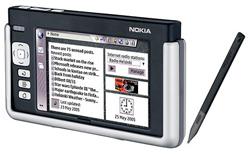Smartphones and lightning-fast tablets. We take then for granted nowadays. With their multi-core processors, generous memory specs, and seemingly endless variety of apps, the concept of a network-connected, hand-held mobile computer certainly isn't new. Years ago, I reported on several cutting-edge wireless devices that were truly ahead of their time. For example, the Linux-powered Nokia 770 hand-held, circa 2006. This little gem sported a screaming 200 MHz ARM processor, 802.11b enabled WiFi, and an 800 x 480 LCD display. Nokia thought they could capture the market with a Linux operating system clone and community application development model. Ari Jaaksi, the 770's development director loaned me one for a review. In spite of the enthusiasm in the market, I don't think they ever sold very many of them. Does anybody remember the HP 3715 Mobile Media Companion? Purchasing one of these $500+ pocket rockets was only possible through a series of articles, I wrote, on how to integrate the thing with a Linux infrastructure. I thought for sure, that this little personal data assistant (PDA) had a bright future. It had good sound card capabilities and could record .wav files with a tiny microphone. It had an 8-hour battery life and a color 320 x 240, touch-screen display that switched between landscape and portrait modes. 152 MB was surely more than enough on-board memory and a full-sized SD memory card slot rounded out the storage package. It also had a 1.2 mega-pixel camera and took very clear pictures. The original 2 GB SD card still has photos from 2005 on it. It's nearly identical in size (well, about twice the thickness) of my current Samsung Galaxy S smart phone. I remember thinking how cool it was to be able to go to Panera Bread and look things up on this tiny little electronic marvel. Alas, the Windows Mobile-based wonder never really caught on. I don't think I've ever seen another one in the wild.
The Palmtop
Of course the crowning achievement of ancient hand-held technology has to be the OQO Palmtop computer. This head-turner was a real fire-breathing monster, with a 1 GHz Transmeta processor, 512 MB of RAM, and 30 GB hard-drive. The 800 x 480 color tablet/touch-screen slid up to reveal a complete thumb keyboard with a mouse stick (for the right thumb) and buttons (under the left thumb). It ran on Li-Polymer batteries and was just slightly larger than my HP iPAQ PDA. The advertised weight was 14 ounces. I remember putting SUSE Linux on it for a review (on loan from OQO) and taking it around the Linux World conference in Boston. There was absolutely nothing like it on the market and it was definitely a geek magnet. Even Rob Malda, from Slashdot, was impressed. Contrast the OQO with my new Asus Transformer Prime. The Prime has a 2.2+ GHz, 4-core specialty processor (and an extra general-purpose core), 1 GB of RAM, 32 GB of solid-state storage, and a rich 1280 x 800 capacity touch-screen display. It runs the latest Android 4.0, Ice Cream Sandwich firmware build. The 1.2 mega-pixel front and 8 mega-pixel cameras make recording HD video and WiFi-connected Skype video calls truly effortless activities. Just today, a friend was lamenting the fact that modern tablets are so expensive. I paid a little over $500 for the Prime, a week ago. I guess the $2100 price tag (in 2006 dollars) for the OQO probably hindered it's popularity. You sure don't see any of them around. What ancient mobile devices, from the distant past, do you remember? Even more importantly, where will the next five or ten years take us? Post a comment to let us know.

